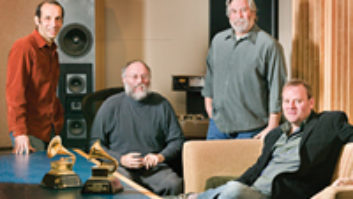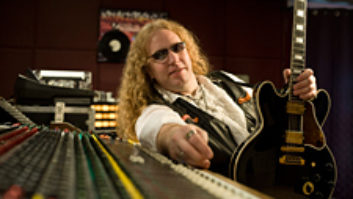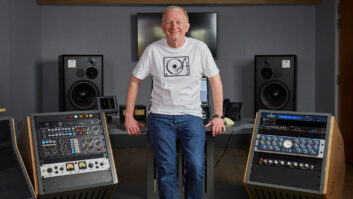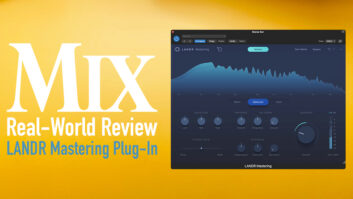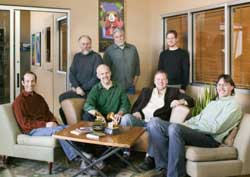
Airshow Mastering’s full staff. Foreground, from left: Dominick Maita, James Tuttle, Jim Wilson and Steven Haver. Background, from left: Charlie Pilzer, David Glasser and Jason McDaniel
Photos: Tim Murphy/Foto Imagery.com
The December 2008 issue of Mix—our annual Mastering Issue—included a news item about Airshow Mastering. Celebrating its 25th anniversary, the company is set to move its Springfield, Va., studio to a new multi-room facility in Takoma Park, Md. We talked to Airshow principals, David Glasser and Charlie Pilzer about the company’s history and expansion.
How does it feel to be turning 25?
Pilzer: It’s been interesting. A lot has happened in the audio world in 25 years. We keep growing, expanding, diversifying, and we feel fortunate, because a lot of other people are closing down. Big studios in New York, L.A. and Nashville have closed.
Glasser: It snuck up on us. We started telling people, and they’re like, “Wow, 25 years in this business? That’s huge.”
What do you think is the secret to staying viable this long?
Pilzer: Customer service. Really helping the artist, the producers, the engineers who bring material to us—helping them fulfill their artistic vision. It’s all about client service. It all starts and ends there.
Glasser: Our clientele has always been independent producers and artists and small labels. The career artists are still going to be making music, because that’s what they do. They haven’t been paralyzed the way larger record labels have been. Our clientele will survive. I also think we’re good at what we do, and we have a good reputation.
Are the methods you used, the things you learned early on, still important to engineers today?
Glasser: Let me give you a few examples of how longevity has been a benefit. New engineers who have never worked in analog are interested in vinyl and working with analog tape. Well, Dominick Maita cut lacquer early in his career, and we’ve all worked in tape for many years. That’s pretty valuable experience, as it turns out. Another example is in high-resolution formats. When we opened in Boulder in 1998, we made a big commitment to DSD and Super Audio CD. While that combination is just a niche format, we’re able to support the audiophile labels who use it, and the experience positioned us for multichannel audio for DVD and Blu Ray. In low-resolution, we have some history, too. We developed workflow for mastering and encoding live shows for quick turnaround in 2000, 2001. From that, in 2005, we founded FestivaLink.net, a live download store for roots music. Today, we provide our mastering clients with digital distribution encoding packages, based on years of experience with different software. Over 25 years, the experience and skill accumulates. Even if we can’t predict what the “next thing” is going to be, we’ll have relevant expertise.
Do you work on vinyl releases?
Glasser: We don’t have a lathe, but we make a version for vinyl and can arrange to have it cut, and we can quality-control the test pressings, too. We usually provide audio that hasn’t been peak-limited, or hasn’t been peak-limited as much as for CD release, and maybe has a different low-end contour.
How did you decide to move the original studio in Springfield into a larger facility?
Pilzer: There are several reasons. One is, here in Springfield, it’s a modest-sized studio, whereas out in Boulder, David has a large room for doing surround and high-resolution mastering. And Dominick Maita and Jim Wilson are out there, and I can see the synergy that comes with having three mastering engineers there, as well as having James Tuttle and Jason McDaniel doing mixing. I’m really inspired by what they did in Boulder.
So Airshow’s new studio, my new studio, will be pretty much a replication of David’s in Boulder. It’s about 375 square feet, and it was designed by Sam Berkow, as David’s was. We’ve designed it to be ready for surround and high-res—whatever the next format’s going to be. I’m putting in similar Dunlavy SC 5 monitoring. We’ve seen the success of that room, and there is no facility like it in D.C. And best of all, I live in Takoma Park. My new studio is 20 minutes’ walk from my house, and right now, it’s an hour commute.
Tell me about the new location, the building itself.
Pilzer: It’s in downtown Takoma Park, which is a 125-year-old Victorian suburb of D.C. It’s five blocks from a Metro rail stop. The building—part of the space was built in the 1930s; the remainder was built in 1940. It was originally built as an auto dealership, and my space was the garage. The original wall structure was terracotta and was half underground, which is good for isolation. It has 13-foot ceilings, and we’re keeping some of the original brickwork and some of the iron work visible: it’s cool, so let’s just feature it.
How is the construction going?
Pilzer: We’re at the wall-construction stage. Next is dry wall and floating floor installation. It’s really exciting, because we worked on the design for several months. When we’re finished, we’ll have two mastering rooms: mine and one for Mike Monseur, my assistant. Mike is very knowledgeable about old recordings and does a lot of restoration work. We share space right now, so it will be great for him to have a dedicated space to work.
Other than the Dunlavy monitors, what mastering equipment will be used in the new studio?
Pilzer: For our workstation, Mike and I both use Sonic Studio soundBlade, and I’m buying a new Maselec MPC2 monitoring console for the new studio. My current Maselec console will be transferred to Mike’s studio. His monitoring will be Dunlavy 3s.
We also each have a small Pro Tools system, plus digital processing by Weiss, Sontec EQ, Manley compression. The thing about any mastering operation is all the gear doesn’t vary much. If you go to mastering studios, it’s all pretty similar. It’s all about the room, and the guy who sits in the room.
The other big part of our new facility is Frank Marchand, who is a mixer/producer who has a studio called Waterford Digital. He’s coming into Airshow and will be sharing the space. So we’re also going to have tracking and mixing, and all that is designed by Sam Berkow, too. I’m excited to have Frank share the space, so we can offer tracking, mixing, mastering, editing, restoration—all in one facility.

Airshow Mastering’s Studio C surround mastering suite
Glasser: It’s a long overdue step, and the folks he’s talked to out there are excited that there’s not only going to be a new mastering studio that will build on what he’s done over the years since I left Springfield, but also that there will be a really nice mid-sized recording studio.
What does it mean in Boulder for Charlie to open his new studio?
Glasser: It will mean a slightly different business structure. What we love about the studio here in Boulder is that there are people coming and going all the time, sharing the lounge or lunch. There are different engineers to bounce ideas off of, and it’s a real community.
What gives you the courage to expand now, at a time when so many studios are going out of business?
Pilzer: They say you have to go forward or you’re going backward; you can’t stand still. I think even if the recording world changes, the need for a good facility to work in doesn’t change. Sure, people work at home, but you still have to have a good facility where you can track drums. We’ll have a Yamaha grand piano—an acoustic grand piano in a real space with wood and slate floors, where you can also get a good drum sound—you can’t do that at home! As good as some of the sampler packages are, there’s no substitute for the real thing, especially in acoustic music. What gives me the ambition or the courage is the fact that there’s always a need for a good facility like that.
Other than building a new studio, what are you guys doing to celebrate your silver anniversary?
Pilzer: We held an event out in Boulder: Mike Spitz from ATR Magnetics came out and ran one of his analog tape seminars. It was fun to spend the whole day delving into analog tape. A lot of studios aren’t maintaining tape. Still, we had a group of folks join us who wanted that valuable training.
Glasser: Afterward, we had a party with 100 people here. It was a lot of fun.
That’s a special group of people who party by taking a seminar about analog tape.
Pilzer: Well, it was special to us!
Glasser: That’s something we like about the audio community here – engineers take their craft seriously, and they enjoy sharing with each other. Charlie has a nonprofit record label, he’s very active in the regional music association, and he’s on the NARAS chapter Board of Governors. The new studio is really an extension of Charlie‘s long involvement in the music community.
SELECTED DISCOGRAPHY
David Glasser
Grateful Dead, Rocking the Cradle: Egypt ’78 (DVD)
Jorma Koukonen, River of Time
Tommy Emmanuel, Center Stage (CD & DVD)
Devotchka, A Mad & Faithful Telling
Tim Reynolds, TR3
Adrian Belew & the Bears, Live at Club Café (DVD)
The Waybacks, From the Pasture to the Future
Charley Patton et al, Screamin’ & Hollerin’ the Blues: The Worlds of Charley Patton
Michael Franti & Spearhead, Power to the Peaceful (CD & DVD)
Otis Taylor, Recapturing the Banjo
Lucy Kaplansky, The Red Thread
Radiators, Dreaming Out Loud
Beausoleil, Alligator Purse
Big Head Todd & The Monsters, Crimes of Passion (Dual Disc)
Various Artists, Smithsonian Folkways’ The Anthology of American Folk Music
Charlie Pilzer
Mary Chapin Carpenter, Come Darkness, Come Light
Sweet Honey in the Rock, Raise Your Voice
Various Artists,I Heard It on NPR
Mendelssohn Piano Trio, Goldmark Piano Trios
The Kennedys, Half a Million Miles
John McCutcheon, Welcome the Traveler Home
Cathy Fink & Marcy Marxer, Scat Like That
Various Artists, Smithsonian Folkways’ The Anthology of American Folk Music
Various Artists, The Heart of Cape Breton
Various Artists, Raw Pre-War Gospel
Marian McPartland, Jazz Christmas
Memphis Slim, The Folkways Years

